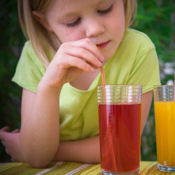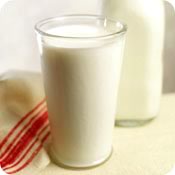 Your child is begging for a soft drink, but you offer him juice instead. It seems like a great compromise--juice is made from fruit, after all--but is that juice box really a healthier option?
Your child is begging for a soft drink, but you offer him juice instead. It seems like a great compromise--juice is made from fruit, after all--but is that juice box really a healthier option? The nutritional facts may surprise you. Certain types of juice have more sugar per serving than soft drinks, and some "fruit juice" isn't all that fruity. So how do you know what juice to give your child? And what should you look for when choosing one? Is juice healthful? Juice does have nutritional benefits; it is made from fruit, after all. However, juice doesn't contain fiber as fruit does, and because it is made by pressing fruit and then removing some of the water to concentrate it, it often contains more calories than a serving of fruit. Juice provides phytonutrients and vitamin C and many are fortified to provide calcium and vitamin D as well. However, only 100% juice contains these nutrients. Other types of juice, those labeled "juice drinks" and "juice cocktails," are much less nutritious, as they are made of mostly corn syrup and artificial flavorings. The U.S. Food and Drug Administration allows beverages to be labeled "juice drinks" if they contain any amount of juice, even just 1% real juice. Read the label to see whether your child's favorite is real juice or a look-alike. Any juice that lists high fructose corn syrup, sugar or another sweetener in the first few ingredients, whether it is bottled, canned, or frozen, should be a red flag that the drink is not actually 100% juice. Most juices found in convenience stores and on supermarket shelves are not actually juice, but sugar-water mixed with artificial flavorings and just 2-5% actual juice. Reading the label is another way to determine whether a juice really contains the fruits it says it does. Many "exotic" or superfood juice blends such as blueberry, pomegranate, or acai are often diluted with apple juice or grape juice. These juices are mild in flavor and much cheaper to produce, so manufacturers often mix them in with the "fancier" juice to save money and stretch the premium product. To make sure that your pomegranate-cran-blueberry juice is actually what it claims to be, check the label for traces of apple or grape juices. What kind should I buy? Juice from concentrate is simply juice that has been reduced down. There is really no difference between the nutritional content between regular juice and prepared juice from concentrate if both juices are actually 100% juice. No doubt about it, 100% juice is the best choice. Vegetable juice, although not usually a favorite among kids, is the best bet, as it is packed with vitamins and minerals and contains far less sugar and fewer calories than fruit juices. As far as fruit juices go, 100% pomegranate juice and blueberry juice are both good choices for a healthy dose of antioxidants. Try diluting these juices with sparkling water to cut calories and sugar. With fizz and sweetness, they're like healthy sodas. For a vitamin C punch to ward off pesky colds, try grapefruit juice, which is one of the lowest-calorie juices per ounce you will find, or cranberry juice (just make sure it's not a juice "cocktail"). Of course, good old orange juice can still have a place at your breakfast table; try varieties that are unsweetened and fortified with calcium and vitamin D. Now that you know what kind of juice to give the kiddies, how much should they be drinking?  How much should I serve?
How much should I serve?While juice is a good source of nutrients, especially for kids who are picky about eating their fruit, portion control is definitely a must. According to the American Academy of Pediatrics, children under six should have no more than 4-6 ounces of juice per day, and children ages seven to eighteen should have no more than 8-12 ounces of juice per day. Many well-intentioned parents allow their children to drink juice with abandon, not realizing how quickly the calories and sugar can add up. Grape juice is the biggest nutritional offender, with 120 calories and 7.5 teaspoons of sugar per six ounces. Apple juice, a common favorite among kids, clocks in at 82.5 calories and 5 teaspoons of sugar. (To put things into perspective, Coca-Cola has 72.5 calories and 5 teaspoons of sugar per six ounces.) Juicy tips Those facts are no reason to ban juice from your kids' diets. Here are some tips that will make moms and children happy:
BabyFit nutritionist Tanya Jolliffe reviewed and approved the content of this article. |
Juicy Little Secrets about Your Child's Favorite Drink
Tips on Choosing the Healthiest Juice Possible
Page 1 of 1





Member Comments